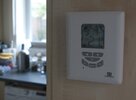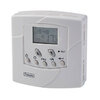Hopefully fairly straightforward ..... my installer is coming here on Friday to move the IDEAL Halo Smart Interface unit from the boiler (a Vogue 32 MAX 2nd Gen Combi - fitted three months ago) FROM the boiler TO a location within the house. The boiler's fitted in an attached garage, separated by a 9 inch wall and the wireless RF signal from the battery operated Halo wall mounted thermostat isn't enough to send a strong signal to the boiler ..... the signal does arrive but the Halo on the wall indicates it's displeasure by turning the strength indicator LED red instead of green. No amount of re-positioning inside the house gives us a good signal.
So he's moving the Interface unit FROM the boiler and repositioning it in the airing cupboard, which has a much better line of sight between the two components. Obviously it will be hard wired (with 1.5mm twin and earth cable) in order to take the 24 volt signal from the Interface in the airing cupboard all the way to the boiler in the garage.
As part of that cable run that I just described a short section of the 24 volt cable is sited in the same plastic trunking as the 240 volt cable that supplies the boiler itself. The two cables are tight up against each other in the trunking for about two metres.
My question is - is it recommended or permitted or advisable to have those two different voltage cables so close for two metres?
I could re-route it but would prefer not to as it means a bit of alteration, but nothing that can't be done. The installer is coming on Friday and I'd like to have it ready for him so would appreciate advice from someone who knows about these things.
For confirmation purposes - Ideal have sent their area engineer to me and he has replaced the two components and the problem has remained. The IDEAL BOOSTER that he recommended didn't do anything and this is his next recommendation. If this doesn't work they'll have to rip it out and fit something else. An EPH CP4 is a possibility. Or a Hive or something else??. But we haven't got there yet.
Thanks in advance
BY THE WAY ....... Maybe this would better in the Electrical forum. Am I allowed to post in two places?
So he's moving the Interface unit FROM the boiler and repositioning it in the airing cupboard, which has a much better line of sight between the two components. Obviously it will be hard wired (with 1.5mm twin and earth cable) in order to take the 24 volt signal from the Interface in the airing cupboard all the way to the boiler in the garage.
As part of that cable run that I just described a short section of the 24 volt cable is sited in the same plastic trunking as the 240 volt cable that supplies the boiler itself. The two cables are tight up against each other in the trunking for about two metres.
My question is - is it recommended or permitted or advisable to have those two different voltage cables so close for two metres?
I could re-route it but would prefer not to as it means a bit of alteration, but nothing that can't be done. The installer is coming on Friday and I'd like to have it ready for him so would appreciate advice from someone who knows about these things.
For confirmation purposes - Ideal have sent their area engineer to me and he has replaced the two components and the problem has remained. The IDEAL BOOSTER that he recommended didn't do anything and this is his next recommendation. If this doesn't work they'll have to rip it out and fit something else. An EPH CP4 is a possibility. Or a Hive or something else??. But we haven't got there yet.
Thanks in advance
BY THE WAY ....... Maybe this would better in the Electrical forum. Am I allowed to post in two places?




